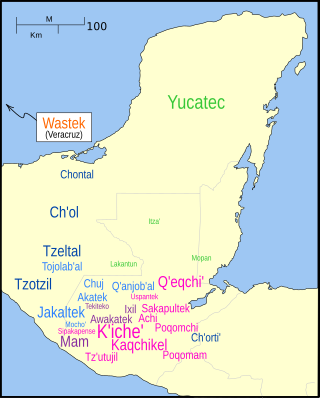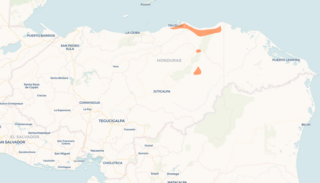Related Research Articles

The Cheyenne language, is the Native American language spoken by the Cheyenne people, predominantly in present-day Montana and Oklahoma, in the United States. It is part of the Algonquian language family. Like all other Algonquian languages, it has complex agglutinative polysynthetic morphology. This language is considered endangered, at different levels, in both states.

The Blackfoot language, also called Siksiká, often anglicised as Siksika, is an Algonquian language spoken by the Blackfoot or Niitsitapi people, who currently live in the northwestern plains of North America. There are four dialects, three of which are spoken in Alberta, Canada, and one of which is spoken in the United States: Siksiká (Blackfoot), to the southeast of Calgary, Alberta; Kainai, spoken in Alberta between Cardston and Lethbridge; Aapátohsipikani, to the west of Fort MacLeod which is Brocket (Piikani) and Aamsskáápipikani, in northwestern Montana. The name Blackfoot probably comes from the blackened soles of the leather shoes that the people wore.
Menominee, also spelled Menomini is an endangered Algonquian language spoken by the historic Menominee people of what is now northern Wisconsin in the United States. The federally recognized tribe has been working to encourage revival of use of the language by intensive classes locally and partnerships with universities. Most of the fluent speakers are elderly. Many of the people use English as their first language.

Crow is a Missouri Valley Siouan language spoken primarily by the Crow Nation in present-day southeastern Montana. The word Apsáalooke translates to "Children of the Large Beaked Bird", which was later incorrectly translated into English as 'Crow'. It is one of the larger populations of American Indian languages with 4,160 speakers according to the 2015 US Census.

Tzeltal or Tseltal is a Mayan language spoken in the Mexican state of Chiapas, mostly in the municipalities of Ocosingo, Altamirano, Huixtán, Tenejapa, Yajalón, Chanal, Sitalá, Amatenango del Valle, Socoltenango, Las Rosas, Chilón, San Juan Cancuc, San Cristóbal de las Casas and Oxchuc. Tzeltal is one of many Mayan languages spoken near this eastern region of Chiapas, including Tzotzil, Chʼol, and Tojolabʼal, among others. There is also a small Tzeltal diaspora in other parts of Mexico and the United States, primarily as a result of unfavorable economic conditions in Chiapas.

Plains Cree is a dialect of the Algonquian language, Cree, which is the most populous Canadian indigenous language. Plains Cree is considered a dialect of the Cree-Montagnais language or a dialect of the Cree language that is distinct from the Montagnais language. Plains Cree is one of five main dialects of Cree in this second sense, along with Woods Cree, Swampy Cree, Moose Cree, and Atikamekw. Although no single dialect of Cree is favored over another, Plains Cree is the one that is the most widely used. Out of the 116,500 speakers of the Cree language, the Plains Cree dialect is spoken by about 34,000 people primarily in Saskatchewan and Alberta but also in Manitoba and Montana.
Wintu is a Wintu language which was spoken by the Wintu people of Northern California. It was the northernmost member of the Wintun family of languages. The Wintun family of languages was spoken in the Shasta County, Trinity County, Sacramento River Valley and in adjacent areas up to the Carquinez Strait of San Francisco Bay. Wintun is a branch of the hypothetical Penutian language phylum or stock of languages of western North America, more closely related to four other families of Penutian languages spoken in California: Maiduan, Miwokan, Yokuts, and Costanoan.
The Ojibwe language is an Algonquian American Indian language spoken throughout the Great Lakes region and westward onto the northern plains. It is one of the largest American Indian languages north of Mexico in terms of number of speakers, and exhibits a large number of divergent dialects. For the most part, this article describes the Minnesota variety of the Southwestern dialect. The orthography used is the Fiero Double-Vowel System.
Bardi is an endangered Australian Aboriginal language in the Nyulnyulan family, mutually intelligible with Jawi and possibly other dialects. It is spoken by the Bardi people at the tip of the Dampier peninsula and neighbouring islands. There are few fluent speakers in the 21st century, but efforts are being made to teach the Bardi language and culture at at least one school.
Ixcatec is a language spoken by the people of the Mexican village of Santa María Ixcatlan, in the northern part of the state of Oaxaca. The Ixcatec language belongs to the Popolocan branch of the Oto-manguean language family. It is believed to have been the second language to branch off from the others within the Popolocan subgroup, though there is a small debate over the relation it has to them.
Proto-Indo-European nominals include nouns, adjectives, and pronouns. Their grammatical forms and meanings have been reconstructed by modern linguists, based on similarities found across all Indo-European languages. This article discusses nouns and adjectives; Proto-Indo-European pronouns are treated elsewhere.

Tiipai (Tipay) is a Native American language belonging to the Delta–California branch of the Yuman language family, which spans Arizona, California, and Baja California. As part of the Yuman family, Tiipai has also been consistently included in the controversial quasi-stock Hokan. Tiipai is spoken by a number of Kumeyaay tribes in northern Baja California and southern San Diego County, California. There were, conservatively, 200 Tiipai speakers in the early 1990s; the number of speakers has since declined steadily, numbering roughly 100 speakers in Baja California in a 2007 survey.

Maliseet-Passamaquoddy is an endangered Algonquian language spoken by the Maliseet and Passamaquoddy peoples along both sides of the border between Maine in the United States and New Brunswick, Canada. The language consists of two major dialects: Maliseet, which is mainly spoken in the Saint John River Valley in New Brunswick; and Passamaquoddy, spoken mostly in the St. Croix River Valley of eastern Maine. However, the two dialects differ only slightly, mainly in their phonology. The indigenous people widely spoke Maliseet-Passamaquoddy in these areas until around the post-World War II era when changes in the education system and increased marriage outside of the speech community caused a large decrease in the number of children who learned or regularly used the language. As a result, in both Canada and the U.S. today, there are only 600 speakers of both dialects, and most speakers are older adults. Although the majority of younger people cannot speak the language, there is growing interest in teaching the language in community classes and in some schools.

In linguistic morphology, inflection is a process of word formation in which a word is modified to express different grammatical categories such as tense, case, voice, aspect, person, number, gender, mood, animacy, and definiteness. The inflection of verbs is called conjugation, and one can refer to the inflection of nouns, adjectives, adverbs, pronouns, determiners, participles, prepositions and postpositions, numerals, articles, etc., as declension.
Munsee is an endangered language of the Eastern Algonquian subgroup of the Algonquian language family, itself a branch of the Algic language family.

Cahuilla, or Ivilyuat, is an endangered Uto-Aztecan language, spoken by the various tribes of the Cahuilla Nation, living in the Coachella Valley, San Gorgonio Pass and San Jacinto Mountains region of southern California. The Cahuilla demonyms include Ɂívil̃uwenetem or Iviatam–speakers of Ivilyuat (Iviɂa)–or táxliswet meaning "person." A 1990 census revealed 35 speakers in an ethnic population of 800. With such a decline, Ivilyuat is classified as "critically endangered" by the UNESCO Atlas of the World's Languages in Danger as most speakers are middle-aged or older with limited transmission rates to children.
This article deals with the grammar of the Udmurt language.

Pech or Pesh is a Chibchan language spoken in Honduras. It was formerly known as Paya, and continues to be referred to in this manner by several sources, though there are negative connotations associated with this term. It has also been referred to as Seco. There are 300 speakers according to Yasugi (2007). It is spoken near the north-central coast of Honduras, in the Dulce Nombre de Culmí municipality of Olancho Department.
Tommo So is a language spoken in the eastern part of Mali's Mopti Region. It is placed under the Dogon language family, a subfamily of the Niger-Congo language family.
This article describes the grammar of the Old Irish language. The grammar of the language has been described with exhaustive detail by various authors, including Thurneysen, Binchy and Bergin, McCone, O'Connell, Stifter, among many others.
References
- 1 2 ""Rou Soulatlouy" Wiyot Conversation Book Project". Wiyot Tribe. Retrieved January 24, 2021.
- ↑ Campbell, Lyle (1997), p. 152
- ↑ Goddard, Ives (1975). Algonquin, Wiyot and Yurok: Proving a Distant Genetic Relationship. The Peter de Ridder Press.
- ↑ Campell, Lynn (1997). American Indian languages: The historical linguistics of Native America. New York City: Oxford University Press.
- ↑ Teeter, Karl V. (1964). The Wiyot Language . Berkeley: The University of California Press. p. 13.